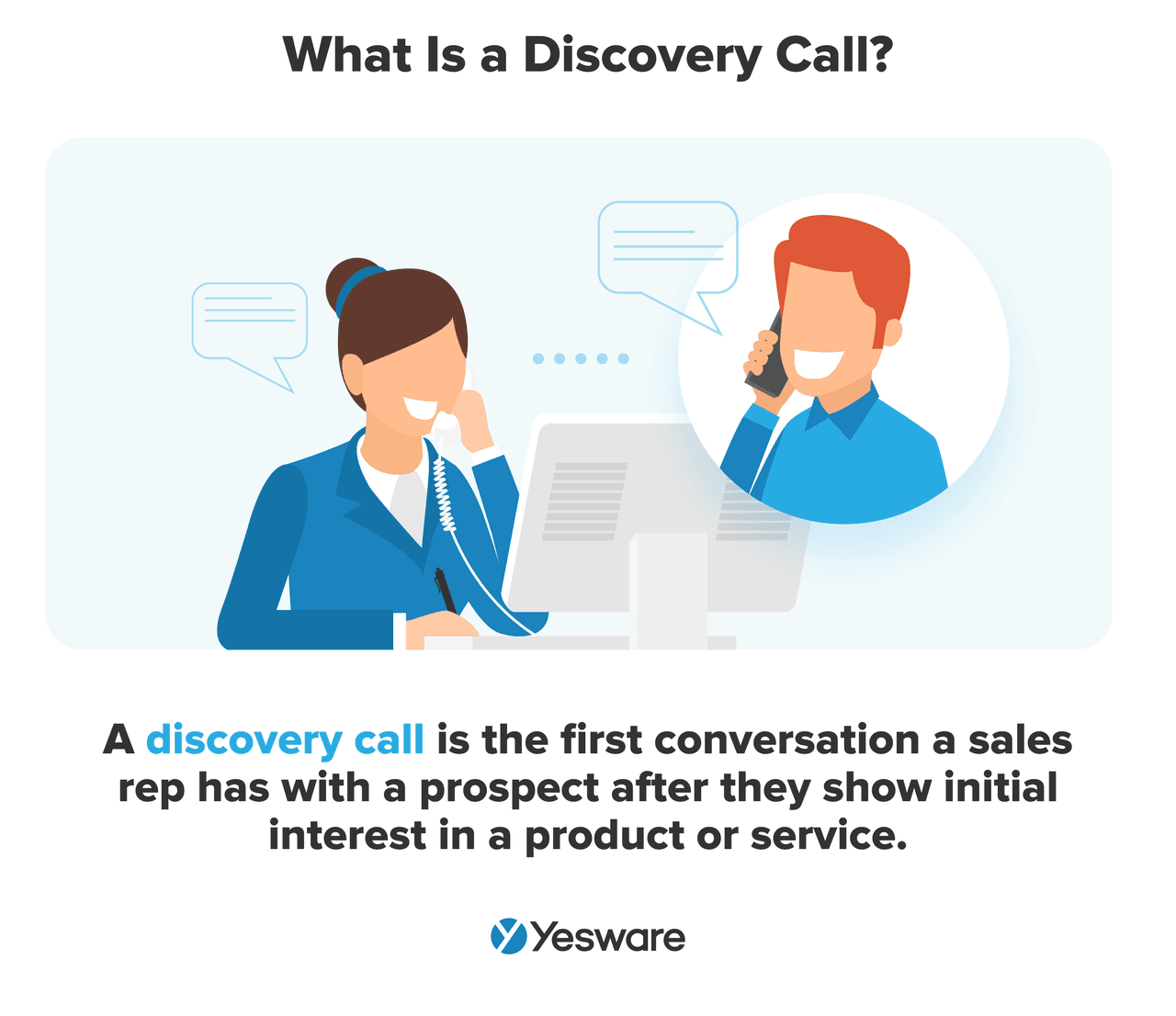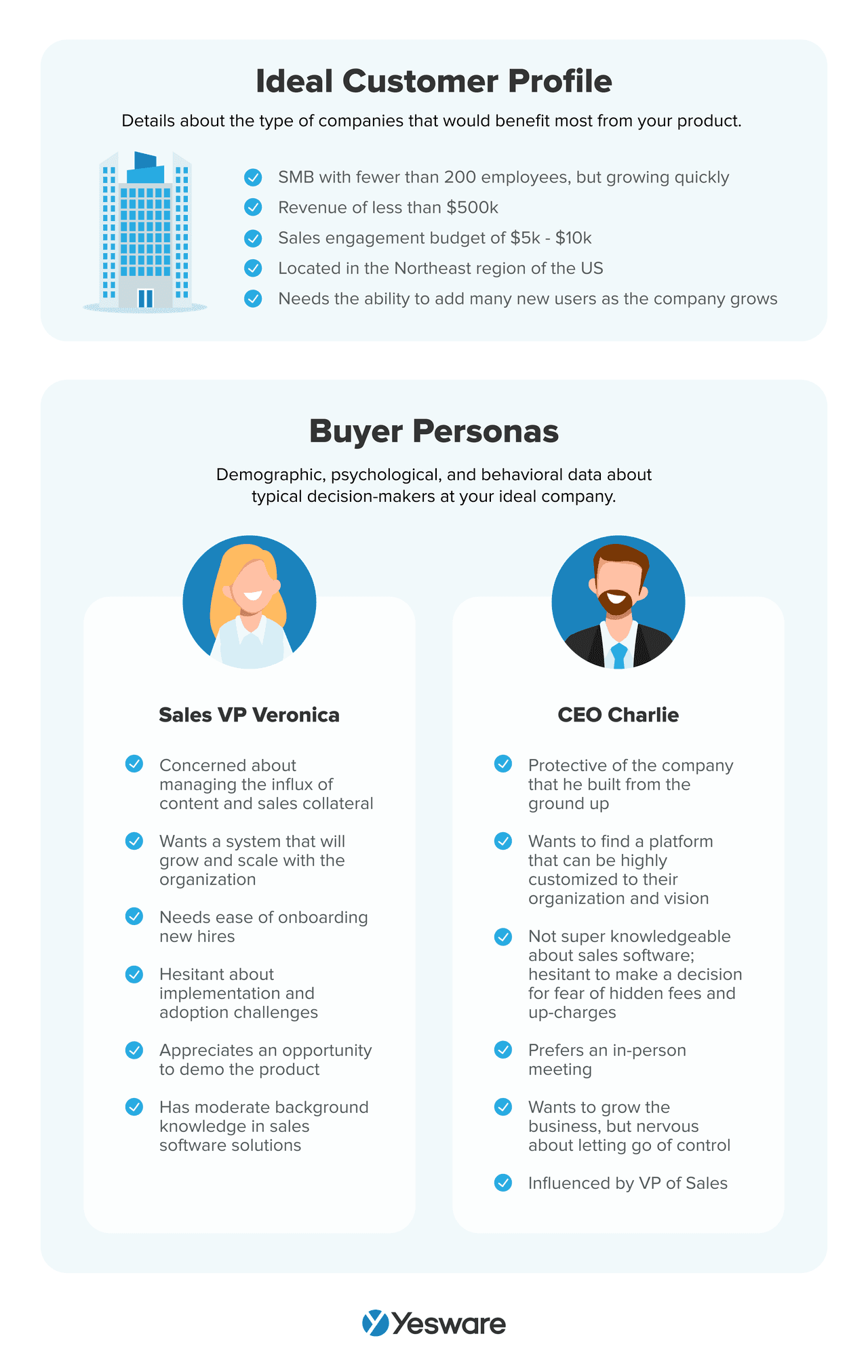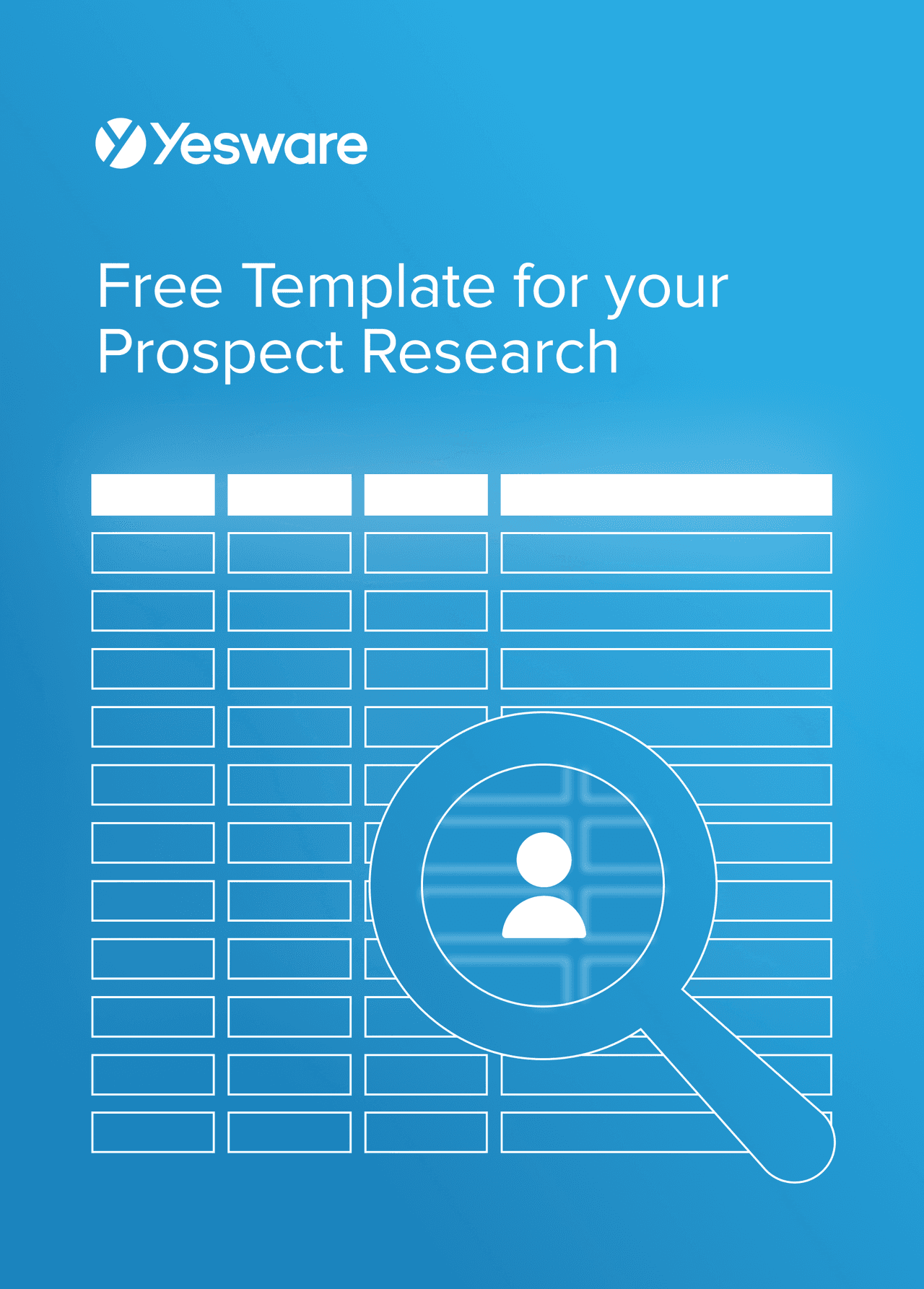Sales Discovery Call: Steps, Checklist, Questions, & Template
Jenny Keohane
Over 50% of your prospects aren’t a good fit for what you sell – this means if you’re not qualifying your prospects correctly in the discovery call – you’re leaving time and money on the table.
Your discovery call is hands down the most important conversation you have in the sales process.
The discovery call either makes or breaks your relationship with the prospect. You can’t move forward in the sales process without this step, and it depicts all future steps going forward.
Below, we look at step-by-step processes, checklists, questions, and templates for salespeople that’ll help identify good fits vs. time-wasters.
Here’s what we’ll cover:
- What Is a Discovery Call?
- Why Discovery Calls Are Important
- 6-Step Process to Execute a Strong Discovery Call
- 30 Discovery Call Questions
- Discovery Call Flow Examples [Template]
- Things to Avoid on a Discovery Call
- Conclusion: Evaluate & Reflect
What Is a Discovery Call?
 A discovery call is the first conversation a sales rep has with a prospect after they show initial interest in a product or service.
A discovery call is the first conversation a sales rep has with a prospect after they show initial interest in a product or service.
Discovery calls are important to leverage a better understanding of the prospect, their business, pain points, and needs. This call helps shape all future conversations and sets the tone for your relationship.
The purpose of a sales discovery call is to determine whether your solution and the prospect are a good fit for one another. Your goal is to either qualify or break up with the prospect, so you’re not wasting either of your time.
Why Discovery Calls Are Important
Discovery calls are crucial to sales success. Here are some of the many reasons why.
- Better understand customer needs: Discovery calls give you the ability to fully dissect the prospect’s pain points and business needs so that you can uncover where your product can come into play.
Identify opportunities: Discovery calls allow you to identify additional products/services that will benefit your prospect through upsell and cross-sell opportunities. - Save time by qualifying or disqualifying: Nobody likes wasting time. Discovery calls allow you to dissect whether the prospect is a good fit for your business or not.
- Make a good first impression: The discovery call is the first conversation you have with the prospect, which means it’s the best time to make a good first impression. If done right, you’ll show the prospect you care about helping them succeed and, ideally, set yourself apart from the competition.
- Move your relationship forward: As stated above, you can’t move forward without this step. The discovery call establishes your relationship and moves the conversation forward, closer to the close.
The key to accomplishing the benefits above is to execute your discovery call correctly. We’ll cover how to do this next.
6-Step Process to Execute a Strong Discovery Call
With the importance of discovery calls, it’s smart to have a standard process in place. This way, you ensure nothing slips through the cracks.
Here’s a 6-step process that ensures all the boxes are checked.

1. Lock Down Your Qualification Criteria
First and foremost, lock down your qualification criteria. The discovery process can’t begin without this step.
Best-fit leads are first identified by demographics like company size, revenue, and maturity, which are outlined in the ideal customer profile (ICP).
Leads are then further qualified by behavioral data through discovery questions. So before you jump on a call, make sure your initial criteria match up.
 Remember: practice makes perfect. Never underestimate the power of role-playing in sales.
Remember: practice makes perfect. Never underestimate the power of role-playing in sales.
Role-playing with a manager can bring a new perspective and insight into your strategy. Collect feedback to improve outcomes and fine-tune your qualifying questions.
It’s also beneficial to record your calls (with permission) and listen back to pick up on moments that could have gone better and identify ways to improve.
2. Do Your Homework
Never pick up the phone without doing your homework. There are tons of information just a click away on Google that can substantially shape your call.
You’ll either 1) enter the call with tailored questions and a better understanding of the prospect/business or 2) be able to disqualify the prospect before the conversation even takes place (which will save you both time and frustration).
Also, you don’t want to be that salesperson who asks questions that are already answered online. It not only wastes time but diminishes your credibility.
Here are three simple steps to follow:
Step One: Check Your CRM
Quickly scan to see the lead source. If your prospect has ever engaged with your marketing content (ebook download, landing page visit, webinar sign-up, etc.), you can reference this on the call.
Also, look for notes on past interactions with other sales team members and the outcome of those conversations.
Step Two: Hit the Company Website
Go to your prospect’s company website and visit each of these four critical pages:
- About Us: Story and core values, leadership, investors, look for similarities or alignment
- Careers / Open Positions: Skills needed/ open pain points, team titles
- News: Announcements, events, funding (reference in convo)
- Blog: Topics, learn what’s top-of-mind at company
Step Three: Look at LinkedIn
First, check their LinkedIn profile to see if you have any mutual connections. Executives (who are often your decision-makers) respond positively to referrals 84% of the time.
Next, take a quick look at their profile and recent activity. Look for a title change, updated experience, likes, group discussions, awards, etc. This will give you insight into their role and responsibilities, plus personal values and interests. Use these to spark conversation and form connections.
Make note of any 1) recent career highs or 2) similarities you share with this person. Here’s why:
- Complimenting personal accomplishments during a sales call creates subconscious, positive attitudes of you and your company. In fact, research shows that even when prospects are aware of flattery being used as a sales tactic, they are still left with an implicit positive impression.
- Similarities draw people together — especially in B2B buying decisions. Sharing even a coincidental similarity with your prospect, such as having the same first name or having attended the same school, can increase their willingness to buy from you.
Here’s a pre-call planning checklist to help you get started.  When the checklist is complete – determine if the prospect is still qualified – and if so, you’re more than prepared for a productive call where you have plenty of resources to lead questions and conversations in the right direction.
When the checklist is complete – determine if the prospect is still qualified – and if so, you’re more than prepared for a productive call where you have plenty of resources to lead questions and conversations in the right direction.
3. Confirm Agenda & Build Rapport
In order to start a robust conversation with questions and honest answers, you need to build rapport at the beginning of the call.
Your first initiative of the discovery call should be to run through the agenda with the prospect. Then make sure to ask them whether there is anything else they’d like to discuss. This shows that you view the call as a 2-way conversation and you want the call to be just as beneficial to the prospect as it is to you.
- What will make this a successful meeting for you?
- I’d like to discuss X, Y, and Z areas. Before we get started, what else would you like to cover in this meeting?
After this, try mentioning something found through your research.
An essential tip for starting a good sales conversation is to enter the call with a custom sentence you’ve found through your research. Whether that’s congratulating them on a recent accomplishment, mentioning a current company announcement, referencing an article or post they wrote, etc.
Discovery Call Spreadsheet
Build out a spreadsheet to enter your discovery calls with connection-builders that’ll help build rapport right off the bat.
Here’s an example of a prospect research spreadsheet for your discovery calls:  Next, find a connection.
Next, find a connection.
Building rapport relies on a connection. And the most effective way to connect with others is on a personal level.
Remember, the person on the other end of the call has a life outside of work. If you can find a way to connect with them personally, the call will go much smoother and feel more natural.
Interested in the spreadsheet above? Grab it for free below.
 Free Template for Your Prospect ResearchThis customizable template will help you organize all prospect research in one place.
Free Template for Your Prospect ResearchThis customizable template will help you organize all prospect research in one place.
Ask Open-Ended Questions
Here are open-ended questions that will spark conversation in your discovery call:
- Is it true what they say about living in [city/state]?
- I see you live in [city/state], have you ever tried [restaurant/local attraction]?
- I’m actually thinking about visiting [city/state] soon, what are your top recommendations?
- I noticed you went to [college/university], I actually have a friend who went there, they said it was really [x]. How did you like it?
- I noticed on LinkedIn you participated in [sport/hobby], I used to play as well, what position were you?
- In your LinkedIn summary, you mentioned you love [x]. How long have you been doing that?
This helps to show the prospect that you’re interested in them and open up conversations where connections can be built.
By doing so, you also help the prospect feel more comfortable with you, which will undoubtedly improve the rest of your conversation.
4. Discover Pain Points
A rule of thumb for your discovery calls: always listen more than you talk.
Remember, at least 50% of your prospects aren’t a good fit for what you sell.
The point of the discovery call is to learn as much about the prospect as possible – a successful discovery call centers the conversation around the prospect and their pain points.
Numerous studies show the power of the talk-listen ratio. Saleshacker found that the highest-yielding B2B sales conversations hovered around a 43:57 talk-to-listen ratio. On average, top sales professionals speak 43% of the time and listen 57% of the time.

The best way to make sure your prospect talks more than you do is to ask questions. But you need to make sure you’re asking the right questions.
Your goal is to ask open-ended sales questions that involve in-depth explanations so you can grasp as much information as possible to tailor your sales pitch around them.
 By asking questions that can’t be answered with a “yes” or a “no,” you encourage dialogue. This dialogue allows sales professionals to uncover pain points, identify interests, and gain visibility into the company.
By asking questions that can’t be answered with a “yes” or a “no,” you encourage dialogue. This dialogue allows sales professionals to uncover pain points, identify interests, and gain visibility into the company.
The information you retain with this dialogue is essential to the discovery process and your future relationship with the buyer.
5. Prescribe the Ideal Solution
If the prospect is a good fit, you’ll understand their pain points. Now it’s time to emphasize these pain points and prescribe your offering as the ideal solution. If you can’t do this, then your solution isn’t the right fit. But don’t cut yourself short; the discovery call is the time to recognize this, which is a job well done.
If you can’t do this, then your solution isn’t the right fit. But don’t cut yourself short; the discovery call is the time to recognize this, which is a job well done.
Since you’ve listened to the prospect speak about their pain points for a large portion of the call, you’re now equipped with the information you need to explain why and how your solution will solve these problems for them.
Connect your prospect’s pain points to specific features and explain how the solution will solve these.
This is a great time to offer case studies or testimonials of similar companies that struggled with similar issues but have since solved them with your solution.
Relate the case study to issues discussed, discuss the ROI customers are currently achieving, and have these close by for reference.
If the discovery call goes well and the prospect is qualified, it’s time to bring it to a close with some strong and notable points.
Confirm that your solution will solve the prospect’s challenges that were brought up in conversation and give a quick indication of why, without over-pitching.
Leave the conversation on a high note, looking forward to the demo where you’ll show the prospect hands-on what you discussed.
6. Schedule Next Steps
Never hang up the phone without discussing the next steps. This step is crucial to put the wheels in motion.
Recommend what you think the next steps should entail and ask for their opinion.
If the discovery call goes as planned, schedule a demo so you can show the prospect how your product or service will solve the pain points and problems raised during the conversation.
And as soon as you hang up the phone, schedule the meeting before anything else.
Also, don’t forget about the follow-up email.
30 Discovery Call Questions
The questions you ask during your discovery call will shape the productivity of the call and the overall outcome.
Here are some questions to help you separate hot leads from time-wasters through important topics.
Understanding the Prospect and Team
1. Walk me through your typical day-to-day activities in your role.
2. What metrics are you responsible for?
3. What are the different roles on your team and how many are in each position?
4. What does your team’s current process look like?
5. What’s holding your team back from achieving your goals?
Understanding Business Problems
6. What’s the business problem you’re looking to fix with this solution?
7. How are you currently handling this problem?
8. How have you tried to resolve this problem in the past?
9. What challenges have you faced in the past when trying to solve these problems?
10. What’s prompting you to do something about this now?
Understanding Competitor Standing
11. What other solutions are you evaluating?
12. How far are you in your evaluation process?
13. How do you feel we compare to the other solutions you’re looking at?
14. Has your company considered or used a solution similar in the past? If so, what happened?
15. How is your current solution meeting your expectations?
16. With your current solution, what’s going right and what’s going wrong?
Understanding the Decision-Making Process & Timing
17. What steps do you need to take in order to make a decision and purchase your chosen solution?
18. Who else on your team should be involved in this process?
19. What is your timeline for making this decision?
20. What types of time constraints are you working with?
21. When would you ideally like to implement a solution for the team?
Understanding Budget
22. What’s your process for securing the budget for this initiative?
23. Do you have a budget allocated?
24. Who is responsible for budget?
25. Who is in charge of financial decisions?
Understanding Roadblocks and Moving Forward
26. Do you have any worries that are holding you back?
27. Do you foresee any pushback from your colleagues against the solution?
28. Which areas of our solution do you still have questions about?
29. Do you have any further questions that we didn’t touch on this meeting?
30. What are you thinking about for the next steps?
Although there are numerous questions above, let’s be clear – pick and choose the most important questions to ask. Don’t interrogate your prospect.
When going into the discovery call, decide on the main topics you want to touch on. Focus on these and ask questions accordingly, don’t go overboard.
Remember, various studies show the top reasons deals fall apart – budget, timing, and decision-making being the top 3. That tells you to address these issues sooner rather than later.

What are the main pieces of information you want to learn about the prospect? Stick to those and form a sequence.
Discovery Call Flow Examples
To help you keep the conversation flowing, we compiled some questions for each section of the discovery call to help you move the conversation forward.  Use the questions below to help you form your own discovery call template.
Use the questions below to help you form your own discovery call template.
Introduction
- Hi [Prospect Name], it’s [Name] from [Company], it’s nice to meet you. I’m looking forward to learning more about your business and how [Product/Service] may be able to help you accomplish [goal].
- Hi [Prospect Name], it’s [Name] from [Company]. Congratulations on [recent accomplishment]; I was on LinkedIn the other day and saw the exciting news. I’m excited to discuss [call purpose]. Is there anything else you’d like to cover today?
- Hi [Prospect Name], it’s [Name] from [Company]. It’s nice to meet you. I’m looking to discuss [X, Y, and Z] today. Does that align with your goals for the call? Am I missing anything?
Building Rapport
- I saw you lived in [Town/City], have you ever been to [Restaurant]? It’s my favorite.
- I saw on your LinkedIn you went to [College/University]. My best friend studied there and loved it. Do you happen to know [Friend’s Name]?
- Before we get started, I wanted to say congratulations on [Company’s recent accomplishment]. That’s awesome. Did you all do something to celebrate?
Discovering Pain Points
- I’m looking to further understand your business needs. Can you tell me a bit more about what problems you’re trying to solve and how you’ve attempted to solve these in the past?
- I know you mentioned you currently use [Current Solution]. What’s going right and what’s going wrong using that solution?
- What are your team’s goals this quarter, and what exactly is holding your team back from reaching those goals?
Identifying Solutions
- Our current customer [Customer Name] had the same issue with [pain point] and solved it using [Product/Solution] by [explanation].
- Based on what we’ve discussed, it sounds like [Product/Solution] will be a great fit for what you’re looking for. Can I give you a quick overview of why I think so?
- I have no doubt that [Product/Solution] will solve [pain points] for you by [explanation]. I’d love to show you exactly how we can do that in a demo of our product. Would you be interested in booking some time for that?
Handling Objections
- Do you foresee any pushback from your team? Can I provide you with resources to help move the conversation forward?
- We’ve found that some customers are hesitant to move forward because of [objection], but I’m here to tell you that [solution to objection]. We want to work with you to develop the ideal solution for your needs.
- Please reach out with any questions or concerns as they arise. I’m here to help you succeed, whether that be with [Product/Solution] or not, so don’t hesitate to reach out.
Next Steps
- Thank you so much for your time today. For the next steps, I’m thinking [X, Y, and Z]. How does that sound? Am I missing anything?
- For our next meeting, how does [Day and Time] work for you? Is there another day that fits your schedule better? I’m flexible.
- It sounds like we agree that [Product/Service] will solve [pain points] for your team. Typically, the next steps are [X, Y, and Z]. What are your ideal next steps? I want to ensure this process is as easy and hassle-free as possible for you and your team.
Remember, when using a discovery call template, don’t use it as a script but as a helpful hand in case you need ideas. Its purpose should be to help guide the conversation forward in case you run into any roadblocks.
Always dissect what is/isn’t working so you can make adjustments and necessary improvements. Take note of what questions are working for you and what aren’t, re-iterate, and keep improving your strategies.
Things to Avoid on a Discovery Call
Now that we’ve discussed all the right things to do in your discovery call, let’s touch on a couple of common mistakes to avoid.
- Don’t talk for long periods of time: Remember, the purpose of the discovery call is to hear your prospect talk, not you.
- Don’t get carried away talking about your product/service: Some sales reps get carried away explaining why their product/service is the right fit for the prospect. Remember the purpose of a discovery call; keep the focus on the prospect as long as possible.
- Don’t overwhelm your prospects with questions: It’s tempting to ask question after question to learn as much about your prospect as possible, but don’t overwhelm them. Stick to around three to four questions. And remember to respond, engage, and further dissect their answers first before moving on to your next question.
Remember to actively listen, respond, and engage. Keep it as conversational as possible.
Evaluate & Reflect – Learn From Every Discovery Call
As stated above, it’s important to always reflect and improve. Similar to many aspects of sales, like cold calling, you should always be looking for ways to improve.
With permission, record your discovery calls. This will help you pinpoint elements that cause confusion or uncertainty and leverage tactics that generate the best results.
Recordings allow you to access what went well and what can be improved. The recording also allows you to take more thorough notes about the conversation to guide you through the rest of the sales process and future interactions.
The best thing you can do the next time you talk to the prospect is reference pain points and discussion points brought up in your discovery call.
Your discovery call sets the pace for the rest of your sales process, so make sure you have a strong process in place.
This guide was updated on August 29, 2023.
Get sales tips and strategies delivered straight to your inbox.
Yesware will help you generate more sales right from your inbox. Try our Outlook add-on or Gmail Chrome extension for free, forever!
Related Articles
Casey O'Connor
Casey O'Connor
Melissa Williams
Sales, deal management, and communication tips for your inbox


